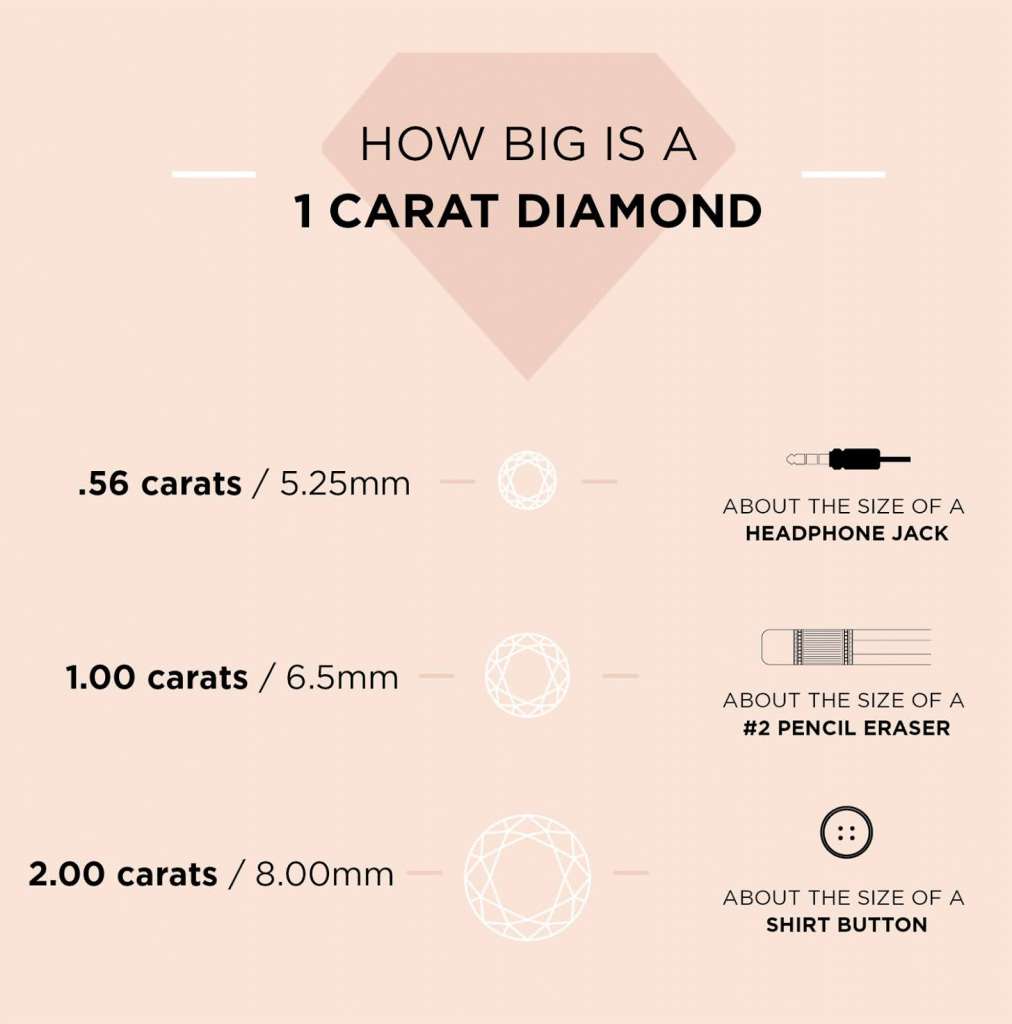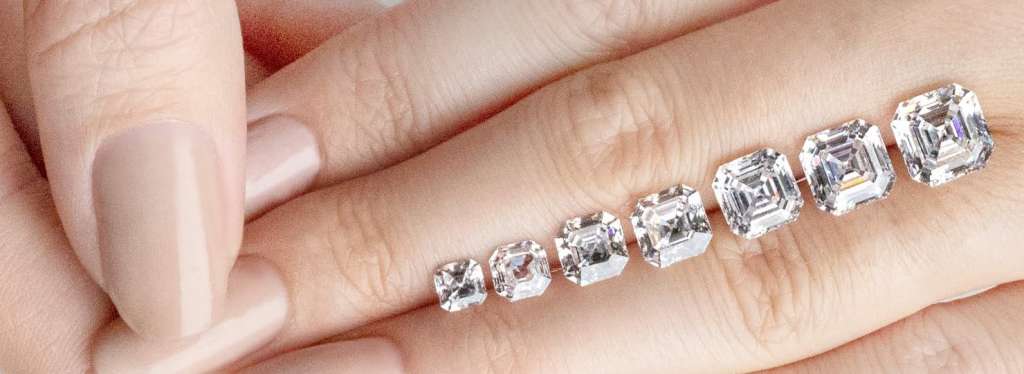Diamonds are forever, so how can you be sure that you’re getting the best deal for your dollar? If you’re in the market to buy a lab diamond engagement ring it’s absolutely essential to allow for plenty of time to browse and budget for your perfect diamond. So, how much are diamonds worth?
However, there are a few things that you should know before you begin your search. In this helpful guide, we’ll tell you everything that you need to know when shopping for a 1 carat, or even 2 carat, loose diamond or diamond engagement ring. From diamond pricing and carat size to diamond shapes and color grade, these are the tips that you need to know to ensure that you get the most beauty and the best value for your stone. So, how much does a 1 carat diamond cost and how much is a 1 carat diamond worth? Let’s talk diamond prices.
How Big Is a 1 Carat Diamond?
Carat is a measure of weight (one-fifth of one gram to be exact), not size. A diamond’s carat weight does not necessarily impact how big it will appear because each diamond shape wears its weight differently. For example, elongated shapes like pear cut diamonds and oval cut diamonds are wider and more flat than other shapes such as the round brilliant diamond cut and Asscher cut rings. Although, carat weight can drastically impact the price of the diamond jewelry. A 1 carat diamond ring with an excellent cut will have a different price compared to a 2 carat diamond engagement ring. Learn more about how carat weight impacts the diamond price if you’ve ever wondered, how much should you spend on an engagement ring?

For this reason, it’s important to understand the measurements of your stone. Do Amore puts it this way, “While a 3 carat stone will, obviously, look larger than a .50 carat stone – the same is not necessarily true for a .90 carat and a 1.10 carat.” This can work in your favor since you might find a stone that’s smaller in carat weight but larger in appearance for a more affordable price. Try browsing non-round diamonds if this sounds appealing to you as fancy cut stones have less specific facet patterns.
A 1 carat round cut diamond will measure around 6.5 mm. However, this number can vary depending upon the stone’s shape and cut quality. In addition, some diamonds are cut deeper than others resulting in carat weight that’s hidden near the bottom of the stone. This can create the illusion that a diamond has a smaller carat weight than it actually does. To avoid this there’s something referred to as an “ideal cut” which states that round diamonds should have a depth percentage of less than 62%. The diamond shape has a huge impact on how big or small the diamond appears to be.
More About Diamond Shapes and Carat Size
As mentioned above, some diamond shapes appear larger to the eye than others despite their carat weight. If you want a bigger look for less money go with an oval, pear or marquise cut diamond. Be aware that other shapes such as cushion, Asscher and princess cut diamonds can appear smaller because they’re cut with deeper depth percentages.
Do Lab Grown Diamonds Weigh The Same as Mined Diamonds?
Yes, lab grown diamonds consist of the same chemical composition as natural diamonds, they are exactly alike even down to their carat weight. The only difference between a mined diamond and a lab grown diamond is their origin; they are equal in diamond worth, but lab grown ones are more affordable. However, this is not the case when it comes to diamond simulants such as moissanite and cubic zirconia which weigh differently than their mined and lab grown diamond counterparts. Moissanite weighs less than a natural diamond, and cubic zirconia weighs significantly more.
How Much Does a 1 Carat Diamond Cost?
According to diamonds.pro, a 1 carat diamond costs anywhere between $1,300 and $16,500. However, a quality diamond doesn’t just come down to size. When assessing diamond value, four very important factors are always taken into consideration – the four c’s of diamond quality: color, cut, clarity and carat.
Color
The Gemological Institute of America (GIA) grades diamonds according to the GIA diamond color scale which organizes diamonds in letter groupings.
The color scale reads as following with D color diamonds rating the highest and Z color rating the lowest:

- A diamond that is graded D-F is absolutely colorless, internally flawless (IF) and very valuable
- Stones ranked G-J are near colorless with a tint that’s so minimal it’s unnoticeable to the untrained eye.
- K-M means that a diamond has light coloring that can be easily seen in larger stones.
- S-Z represents diamonds with light coloring that can be seen with the naked eye in all sizes.
Cut
Perhaps the most important of the four c’s, cut grade directly influences the look of a diamond. However, it should be noted that the cut of a diamond doesn’t only refer to how a stone is shaped.
Diamond Nexus explains cut as, “assessing how well the diamond interacts with light in a proportional, polished, symmetrical way. A poor cut can make your gemstone look dull and lifeless. A brilliant cut diamond is essential for a diamond to sparkle as diamonds do to be considered valuable.”

Three factors are assessed when determining the cut quality of a diamond: fire, brightness and scintillation. Fire represents the way a diamond sparkles in the light. Brightness is the reflection of white light on a diamond’s internal and external surfaces. And lastly, scintillation is defined as patterns of light and dark that are noticeable when a diamond is moved or tilted.
Clarity
Diamond clarity refers to everything in a diamond that might affect how light passes through it. Diamond experts such as jewelers and gemologists assess clarity by looking at a stone’s surface blemishes, inclusions and transparency. Inclusions occur when minerals form crystals, winning wisps or needle-like shapes in a stone. Most inclusions are nearly impossible to spot with the naked eye, however, they can still negatively impact a gemstone’s value.
Similar to diamond color, diamond clarity is also ranked according to a scale established by the GIA. The clarity grading scale is the diamond industry standard to determine a stone’s clarity and value in a way that was easy for consumers to understand.

The clarity grades are as follows from highest to lowest:
- Flawless (FL): No inclusions or blemishes visible under 10x magnification
- Internally Flawless (IF):Diamonds that contain no visible inclusions under 10x magnification
- Very, Very Slightly Included (VVS1 and VVS2):Diamonds that have inclusions that are so slight that they are difficult for even a skilled grader to see under 10x magnification.
- Very Slightly Included (VS1 and VS2):VS1 and VS2 clarity means that inclusions can be observed with effort under 10x magnification, but can still be characterized as minor
- Slightly, Included (SI1 and SI2):Inclusions are noticeable under 10x magnification
- Included (I1, I2 and I3):Inclusions are obvious under 10x magnification
- High quality stones should have a clarity of VVS1 or better.
Carat
Again, carat is a measurement used to determine the weight of a diamond. A blog from Diamond Nexus puts it this way, “The main thing to remember is that the higher the diamond carat weight, the more a diamond is worth because large diamonds are rare. However, if you take two smaller diamonds that weigh the same in carats and compare them, the value for each can be wildly different due to other measurable factors, like color grade, how brilliant the cut is, and whether the clarity is internally flawless. That means that a larger diamond is nearly always worth more than multiple smaller ones, even if it’s the same carat size.

How Much Does a 2 Carat Diamond Cost?
According to diamonds.pro and their diamond price chart you can expect to spend anywhere between $5,000 to $60,000 or more on a 2 carat diamond from your local jewelry store or online retailer. While these figures might have you suffering from a bit of sticker shock, this massive price difference occurs because diamond cost varies based on a stone’s shape, cut quality, clarity and color. In addition, as diamond carat size increases, so does the stone’s rarity. Diamond prices go up exponentially as carat weight increases.
When it comes to quality, you get what you pay for. For example, there are stunning 2 carat diamonds that check all the boxes of the four c’s near the top of the spectrum and poorly cut, dull 2 carat diamonds near the bottom of the spectrum that will cost you significantly less.
Diamonds.pro advises the following, “because no two diamonds are exactly the same, we recommend evaluating the four cs of diamond quality for each stone you look at. Focusing on quality over specific carat weight will get you the most beauty for your budget, especially for a larger stone like a 2 carat diamond.
Fake it ‘Til You Make it
If your partner expressed interest in a 2 carat diamond ring but it’s simply out of budget have no fear. There are a few ways you can achieve the look of a 2 carat diamond without racking up some massive credit card debt.
The first trick is to choose a halo setting which will create the illusion of a larger diamond by adding a ring of smaller stones around the center diamond. Or, you can amp up the sparkle factor with an accented band which allows you to have the entire ring add up to 2 carats total weight when you account for all of the smaller diamonds that surround your center stone. For more help, check out the best places to buy engagement rings.
Additionally, try a lab grown diamond as they are often more affordable than a mined diamond. They are great value because they still possess the same physical and chemical properties of a real diamond, all while being eco-friendly and conflict-free. Check out how you can design and customize the perfect ring today.






Leave a Comment